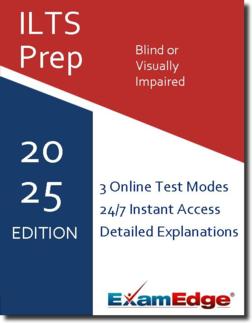ILTS Teacher of Students Who Are Blind or Visually Impaired (228) Practice Tests & Test Prep by Exam Edge - Topics
Based on 25 Reviews
- Real Exam Simulation: Timed questions and matching content build comfort for your ILTS Blind or Visually Impaired test day.
- Instant, 24/7 Access: Web-based ILTS Teacher of Students Who Are Blind or Visually Impaired practice exams with no software needed.
- Clear Explanations: Step-by-step answers and explanations for your ILTS exam to strengthen understanding.
- Boosted Confidence: Reduces anxiety and improves test-taking skills to ace your ILTS Teacher of Students Who Are Blind or Visually Impaired (228).

Understanding the exact breakdown of the ILTS Teacher of Students Who Are Blind or Visually Impaired test will help you know what to expect and how to most effectively prepare. The ILTS Teacher of Students Who Are Blind or Visually Impaired has 100 multiple-choice questions The exam will be broken down into the sections below:
| ILTS Teacher of Students Who Are Blind or Visually Impaired Exam Blueprint | ||
|---|---|---|
| Domain Name | % | Number of Questions |
| Understanding Students Who Are Blind or Visually Impaired | 17% | 17 |
| Assessing Students and Developing Individualized Learning | 25% | 25 |
| Promoting Students' Communication, Social, and Independent Living Skills | 17% | 17 |
| Managing the Learning Environment and Planning and Delivering Instruction | 24% | 24 |
| Maintaining Effective Communication, Collaboration, and Professionalism | 17% | 17 |


